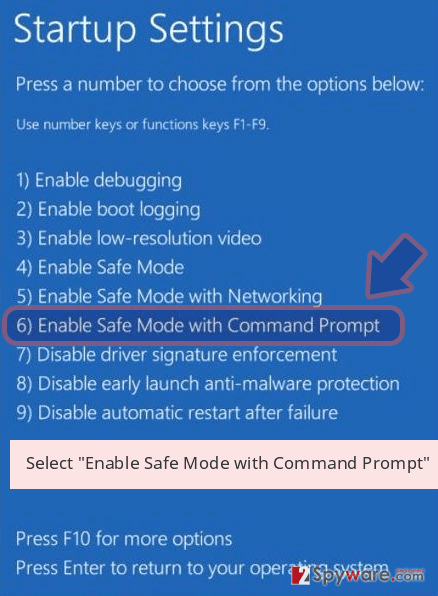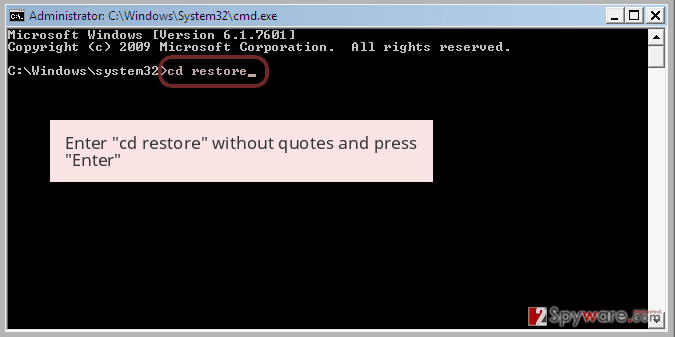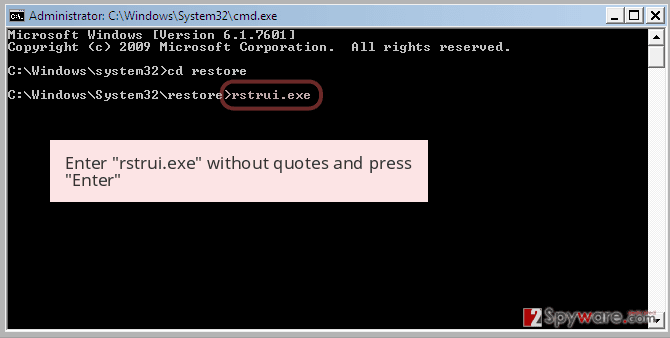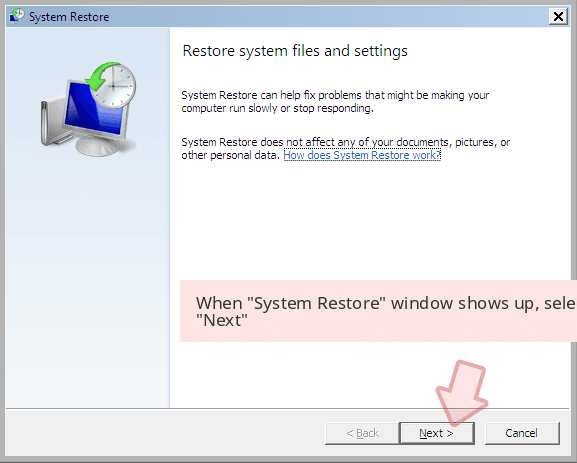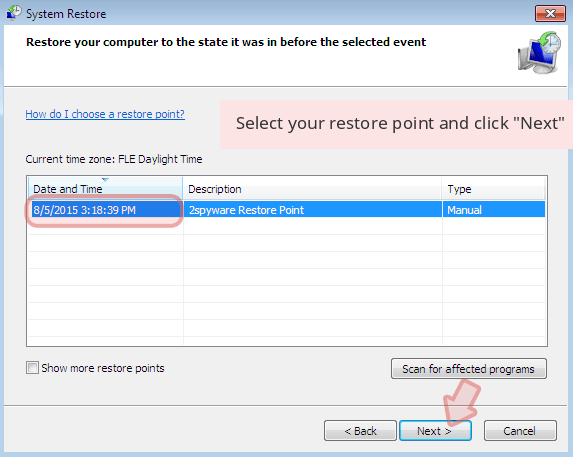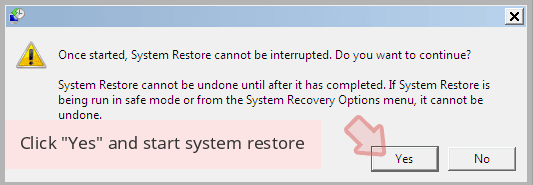Evil Locker ransomware (Virus Removal Guide) - Recovery Instructions Included
Evil Locker virus Removal Guide
What is Evil Locker ransomware?
Evil Locker ransomware is a file-encrypting virus which compromises data on victim's computer
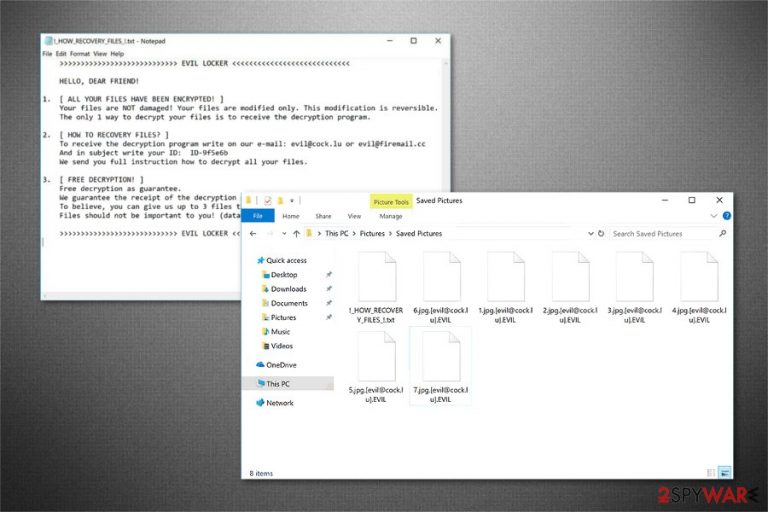
Evil Locker is a virus which is designed to perform data encryption. The compromised files are appended with .[evil@cock.lu].EVIL or .[evil@firemail.cc].EVIL extensions and become unusable. Victims receive !_HOW_RECOVERY_FILES_!.txt ransom note in which users are demanded to contact the criminals via evil@cock.lu or evil@firemail.cc email addresses and pay the ransom. The price of the decryption tool offered by the cybercriminals is yet unknown.
| Name | Evil Locker |
|---|---|
| Type | Ransomware |
| Danger level | High |
| Ransom note | !_HOW_RECOVERY_FILES_!.txt |
| Extension | .EVIL |
| Contact emails | evil@cock.lu, evil@firemail.cc |
| Distribution | Hackers distribute the infection via malicious spam emails or unprotected P2P file-sharing sites |
| Main dangers | It can lead to data and financial losses or infiltrate the system with malware |
| Elimination | The safest way to uninstall Evil Locker ransomware is get FortectIntego or another reliable antivirus |
Usually, the systems can get infected with Evil Locker ransomware if users open suspicious spam emails with malicious attachments which hold the payload of the file-encrypting virus. After the infiltration, the crypto-malware starts encoding the most widely used documents on the system and drops the following ransom-demanding message:
>>>>>>>>>>>>>>>>>>>>>>>>>>>> EVIL LOCKER <<<<<<<<<<<<<<<<<<<<<<<<<<<<
HELLO, DEAR FRIEND!1. [ ALL YOUR FILES HAVE BEEN ENCRYPTED! ]
Your files are NOT damaged! Your files are modified only. This modification is reversible. The only 1 way to decrypt your files is to receive the decryption program.2. [ HOW TO RECOVERY FILES? ] To receive the decryption program write on our e-mail: evil@cock.lu or evil@firemail.cc And in subject write your ID: ID-[redacted 6 hex char] We send you full instruction how to decrypt all your files.
3. [ FREE DECRYPTION! ] Free decryption as guarantee. We guarantee the receipt of the decryption program after payment. To believe, you can give us up to 3 files that we decrypt for free. Files should not be important to you! (databases, backups, large excel sheets, etc.)
>>>>>>>>>>>>>>>>>>>>>>>>>>>> EVIL LOCKER <<<<<<<<<<<<<<<<<<<<<<<<<<<<
Even though the attackers claim that they have Evil Locker decryptor, there are no guarantees that they are willing to send it to the victim after the transaction[1]. Therefore, our experts recommend you not to fall into the trap of cybercriminals and refuse to pay the ransom.
In fact, you can recover files with .EVIL extension if you have backups stored in the cloud. Note that, paying to the hackers might not only lead to financial losses but also motivate them to continue their malicious activity and continue infecting more systems.
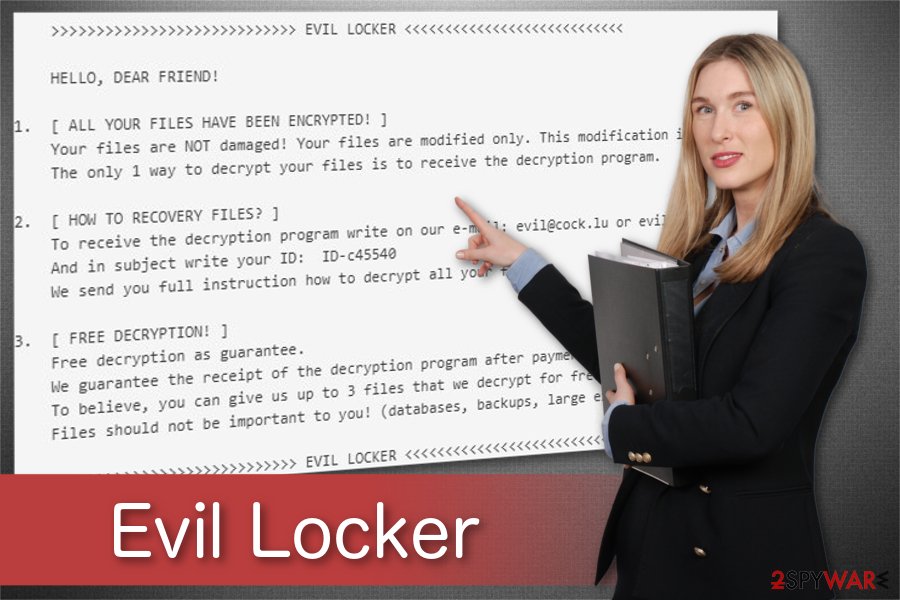
If you do not have backups, there are alternative ways how you can get back the access to the compromised data. Although, you must remove Evil Locker first. For that, we suggest employing robust security tools to ensure that all core files are uninstalled from the infected system.
Evil Locker removal is an advanced procedure which should be held with extreme care. Therefore, do not try to get rid of the malware on your own. You can either fail to delete the virus or even damage your system permanently. A more detailed guide showing how to clean your system is presented at the end of this article.
Ransomware attack vectors explained
Usually, ransomware developers employ similar distribution techniques which are widely known for some time now. Likewise, it is essential to understand how file-encrypting viruses spread in order to protect your system. The most common ransomware attack vectors are the following:
- Fake software updates[2];
- Software cracks;
- Spam emails;
- Malicious ads.
Our experts recommend you to stay away from unprotected P2P file-sharing sites where people come to download software illegally. Instead, choose verified websites and avoid clicking on commercial content online. People often fail to identify potentially dangerous ads which are designed to redirect to malicious sites.
Finally, the most critical step is to monitor your inbox carefully. A vast of ransomware payloads are delivered via spam emails as innocent-looking attachments. If you click on one of them, the malware will start data encryption. Thus, NEVER open suspicious emails from people or companies you are not aware of.
Terminating Evil Locker virus is essential
You can remove Evil Locker virus with professional tools only. Ransomware-type cyber threats are sophisticated and programmed to run at the startup. Thus, you cannot get rid of it in a straightforward manner.
Additionally, it is essential to perform complete Evil Locker removal. In other terms, you must delete all files related to the crypto-malware, and it can only be achieved with professional tools.
Cybersecurity researchers[3] indicate that the most effective tools designed for novice PC users are FortectIntego, SpyHunter 5Combo Cleaner, and Malwarebytes. We strongly recommend you to stay cautious and get professional help.
Getting rid of Evil Locker virus. Follow these steps
Manual removal using Safe Mode
Disable Evil Locker ransomware by rebooting your system to Safe Mode with Networking as shown below:
Important! →
Manual removal guide might be too complicated for regular computer users. It requires advanced IT knowledge to be performed correctly (if vital system files are removed or damaged, it might result in full Windows compromise), and it also might take hours to complete. Therefore, we highly advise using the automatic method provided above instead.
Step 1. Access Safe Mode with Networking
Manual malware removal should be best performed in the Safe Mode environment.
Windows 7 / Vista / XP
- Click Start > Shutdown > Restart > OK.
- When your computer becomes active, start pressing F8 button (if that does not work, try F2, F12, Del, etc. – it all depends on your motherboard model) multiple times until you see the Advanced Boot Options window.
- Select Safe Mode with Networking from the list.
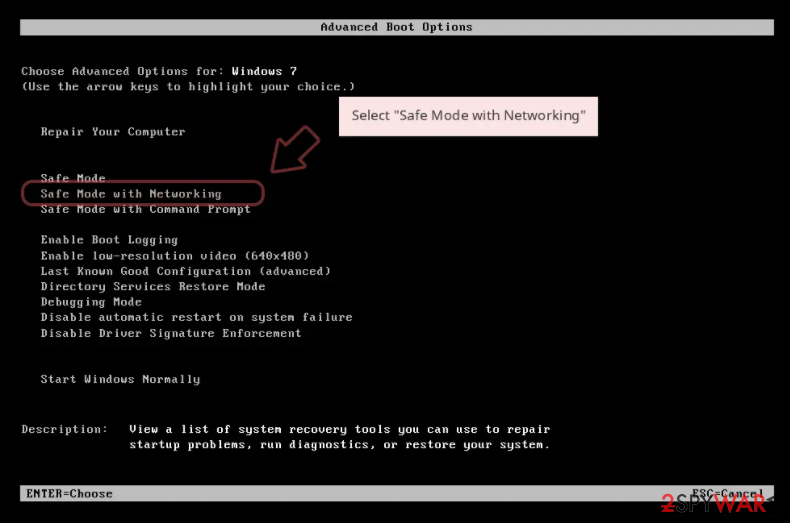
Windows 10 / Windows 8
- Right-click on Start button and select Settings.
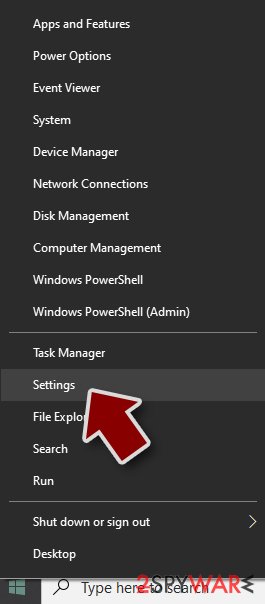
- Scroll down to pick Update & Security.
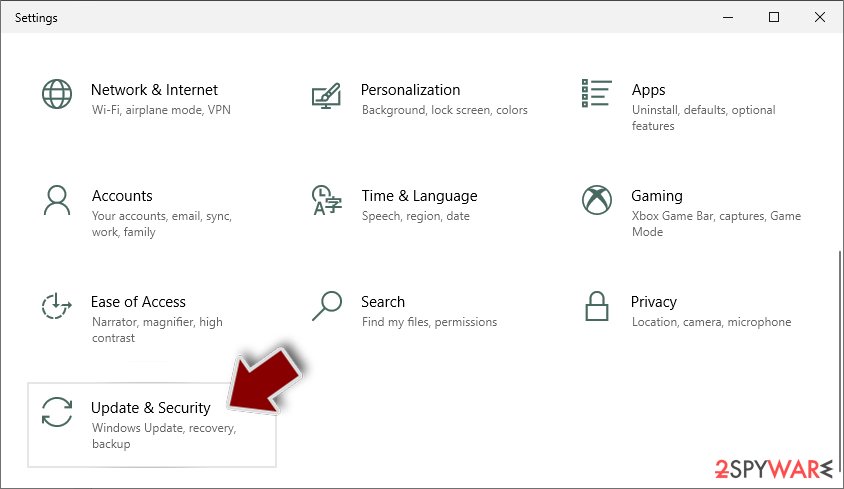
- On the left side of the window, pick Recovery.
- Now scroll down to find Advanced Startup section.
- Click Restart now.
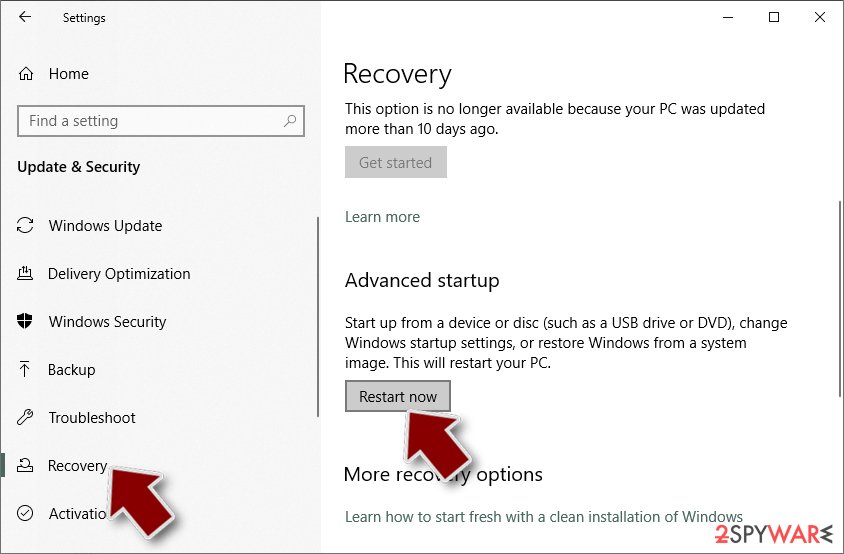
- Select Troubleshoot.
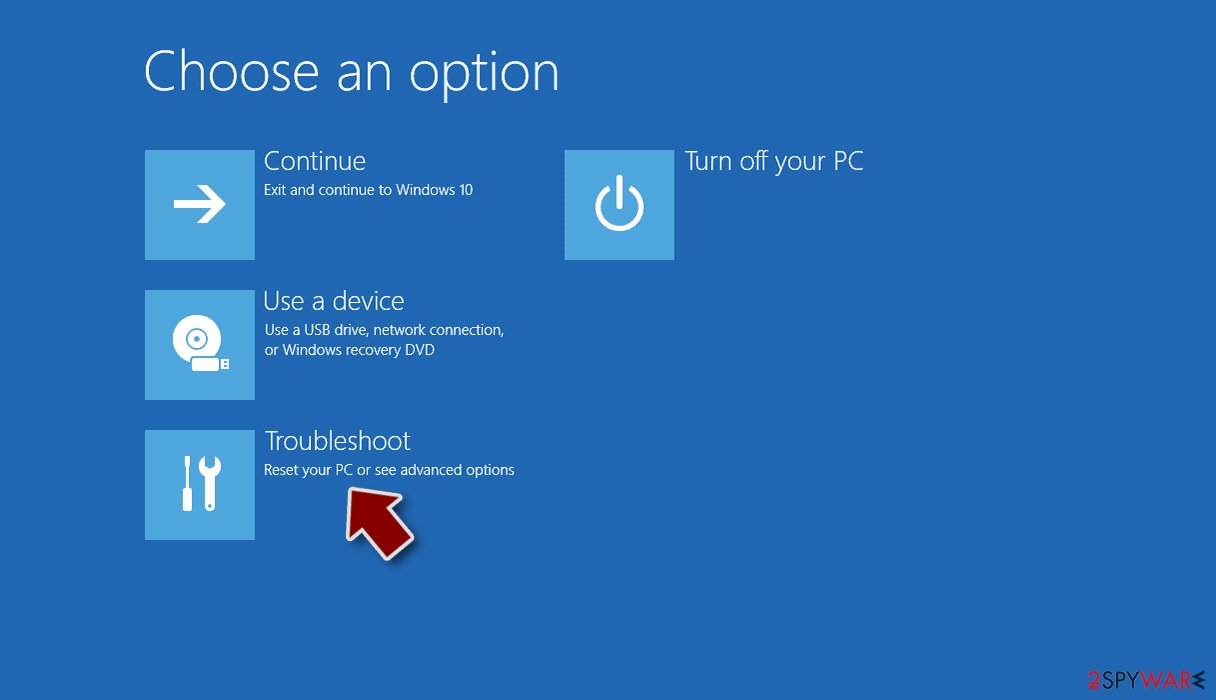
- Go to Advanced options.
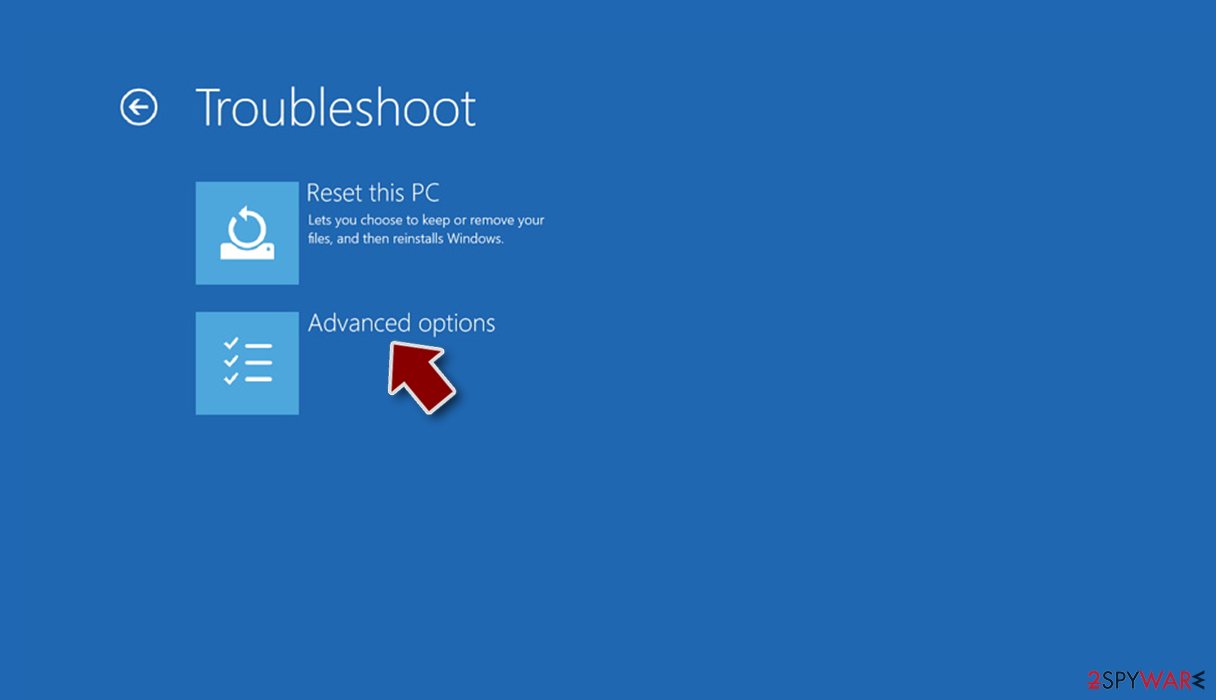
- Select Startup Settings.
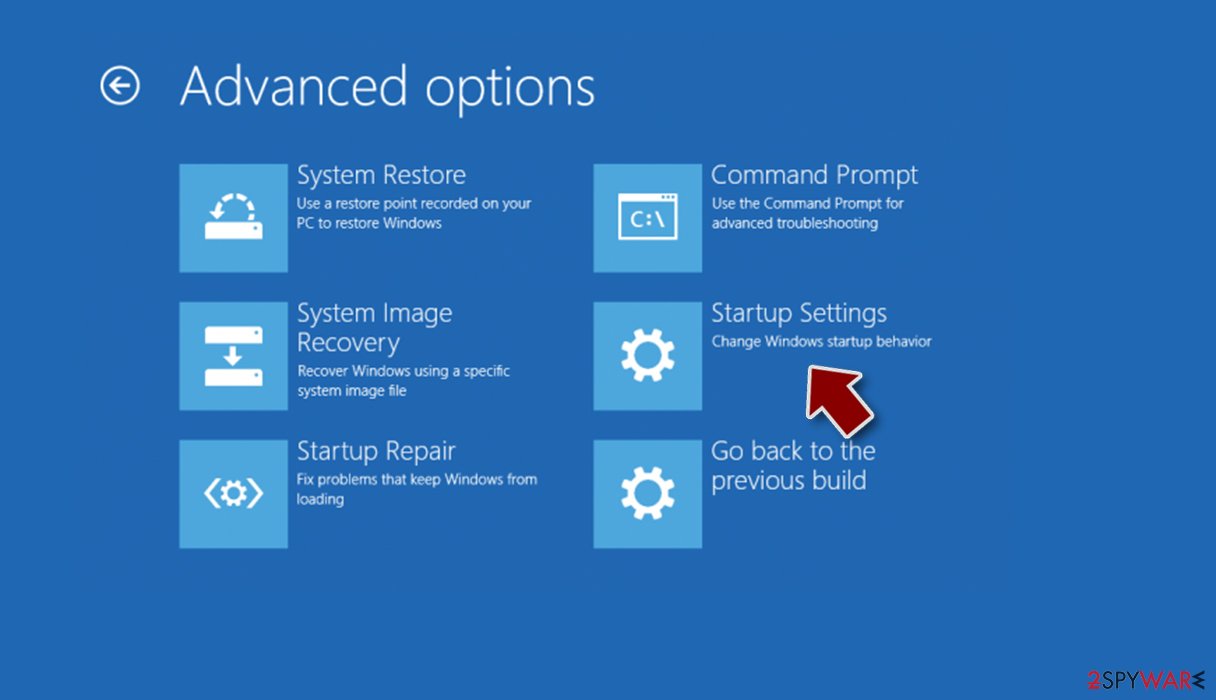
- Press Restart.
- Now press 5 or click 5) Enable Safe Mode with Networking.
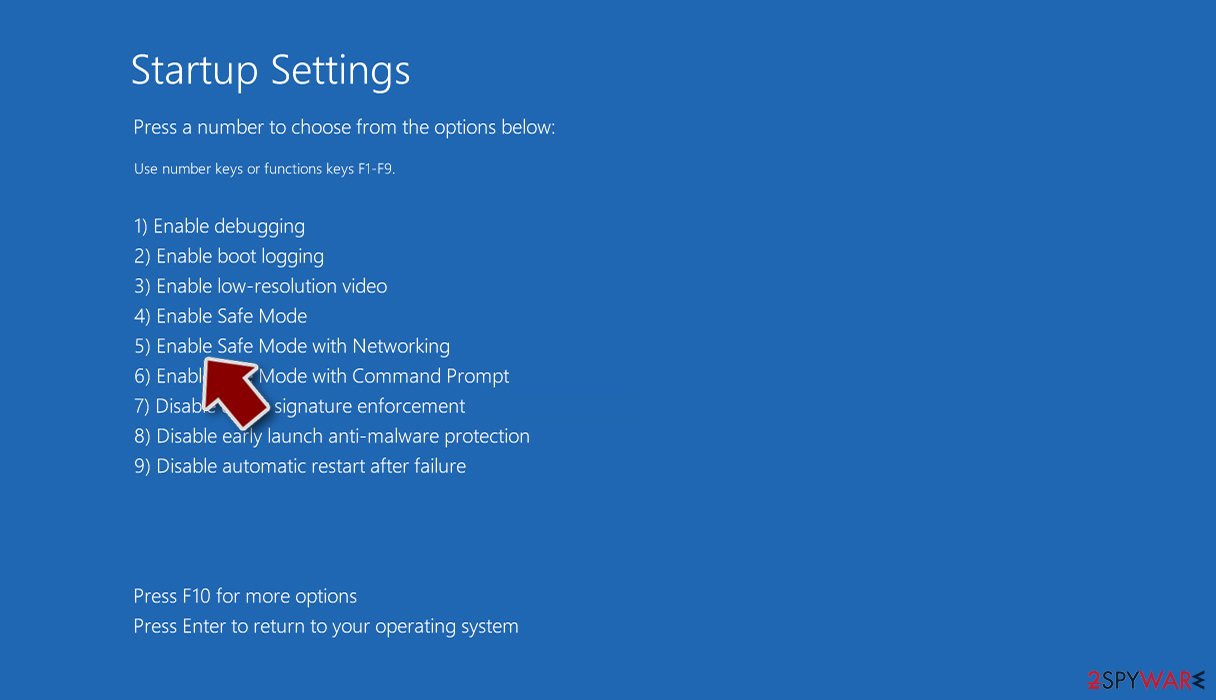
Step 2. Shut down suspicious processes
Windows Task Manager is a useful tool that shows all the processes running in the background. If malware is running a process, you need to shut it down:
- Press Ctrl + Shift + Esc on your keyboard to open Windows Task Manager.
- Click on More details.
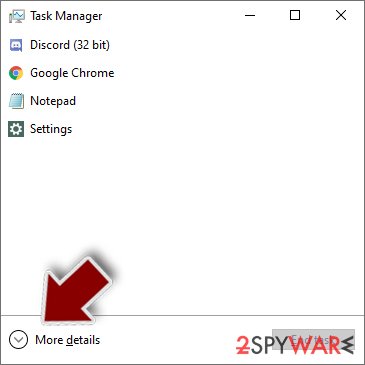
- Scroll down to Background processes section, and look for anything suspicious.
- Right-click and select Open file location.
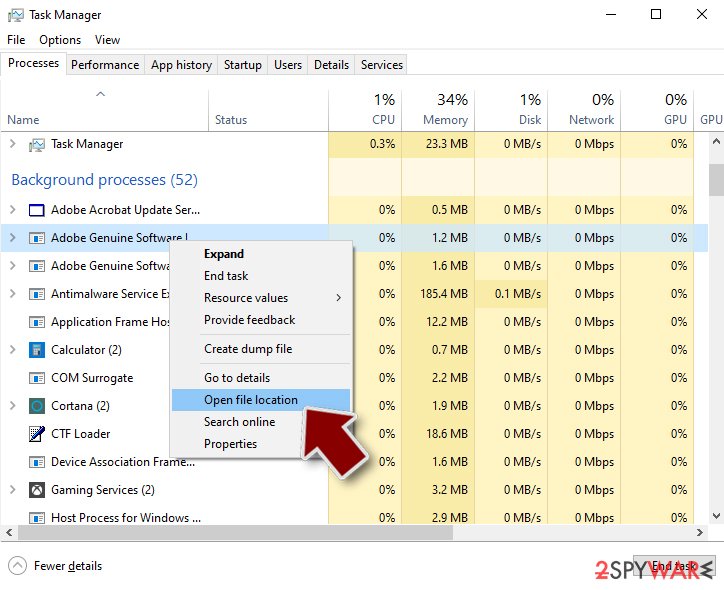
- Go back to the process, right-click and pick End Task.
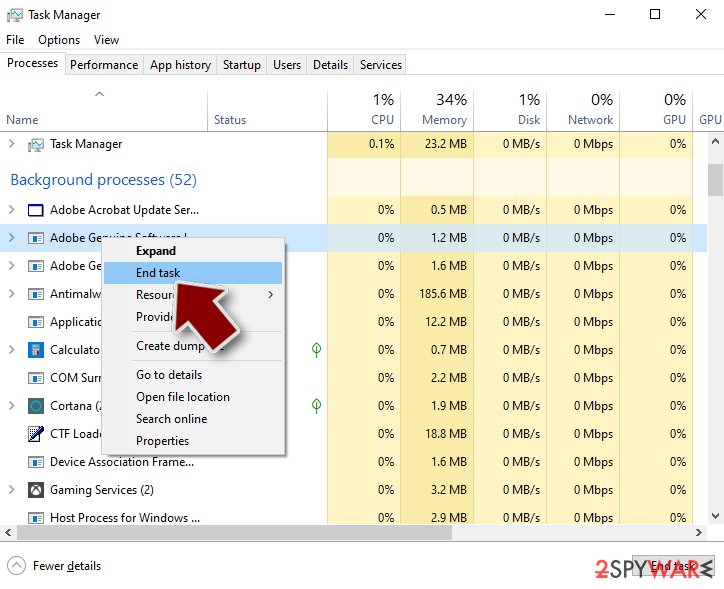
- Delete the contents of the malicious folder.
Step 3. Check program Startup
- Press Ctrl + Shift + Esc on your keyboard to open Windows Task Manager.
- Go to Startup tab.
- Right-click on the suspicious program and pick Disable.
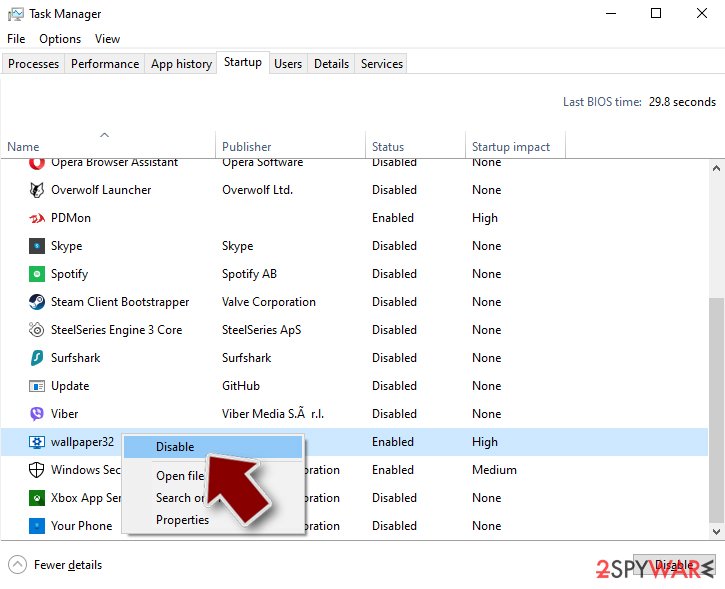
Step 4. Delete virus files
Malware-related files can be found in various places within your computer. Here are instructions that could help you find them:
- Type in Disk Cleanup in Windows search and press Enter.
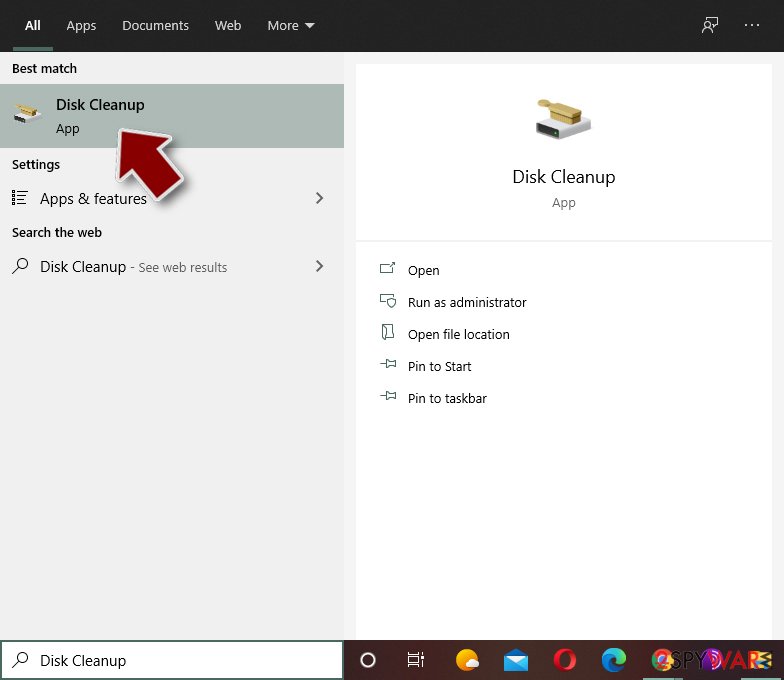
- Select the drive you want to clean (C: is your main drive by default and is likely to be the one that has malicious files in).
- Scroll through the Files to delete list and select the following:
Temporary Internet Files
Downloads
Recycle Bin
Temporary files - Pick Clean up system files.
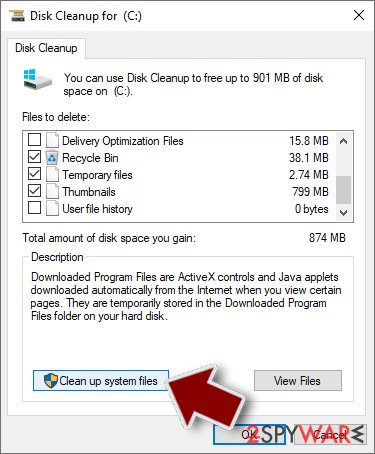
- You can also look for other malicious files hidden in the following folders (type these entries in Windows Search and press Enter):
%AppData%
%LocalAppData%
%ProgramData%
%WinDir%
After you are finished, reboot the PC in normal mode.
Remove Evil Locker using System Restore
-
Step 1: Reboot your computer to Safe Mode with Command Prompt
Windows 7 / Vista / XP- Click Start → Shutdown → Restart → OK.
- When your computer becomes active, start pressing F8 multiple times until you see the Advanced Boot Options window.
-
Select Command Prompt from the list

Windows 10 / Windows 8- Press the Power button at the Windows login screen. Now press and hold Shift, which is on your keyboard, and click Restart..
- Now select Troubleshoot → Advanced options → Startup Settings and finally press Restart.
-
Once your computer becomes active, select Enable Safe Mode with Command Prompt in Startup Settings window.

-
Step 2: Restore your system files and settings
-
Once the Command Prompt window shows up, enter cd restore and click Enter.

-
Now type rstrui.exe and press Enter again..

-
When a new window shows up, click Next and select your restore point that is prior the infiltration of Evil Locker. After doing that, click Next.


-
Now click Yes to start system restore.

-
Once the Command Prompt window shows up, enter cd restore and click Enter.
Bonus: Recover your data
Guide which is presented above is supposed to help you remove Evil Locker from your computer. To recover your encrypted files, we recommend using a detailed guide prepared by 2-spyware.com security experts.If your files are encrypted by Evil Locker, you can use several methods to restore them:
Data Recovery Pro tool is helpful after the ransomware attack
Experts suggest using this professional software if your files have been compromised or accidentally deleted.
- Download Data Recovery Pro;
- Follow the steps of Data Recovery Setup and install the program on your computer;
- Launch it and scan your computer for files encrypted by Evil Locker ransomware;
- Restore them.
Windows Previous Versions feature can help recover individual files with .EVIL extension
If you have enabled System Restore function before ransomware settled on your PC, try to travel back in time and get back the access to the corrupted data.
- Find an encrypted file you need to restore and right-click on it;
- Select “Properties” and go to “Previous versions” tab;
- Here, check each of available copies of the file in “Folder versions”. You should select the version you want to recover and click “Restore”.
Ways to recover files with ShadowExplorer
Check if the file-encrypting virus hasn't deleted Shadow Volume Copies of the encrypted files. If not, follow the steps below:
- Download Shadow Explorer (http://shadowexplorer.com/);
- Follow a Shadow Explorer Setup Wizard and install this application on your computer;
- Launch the program and go through the drop down menu on the top left corner to select the disk of your encrypted data. Check what folders are there;
- Right-click on the folder you want to restore and select “Export”. You can also select where you want it to be stored.
Official Evil Locker decryptor is currently under development.
Finally, you should always think about the protection of crypto-ransomwares. In order to protect your computer from Evil Locker and other ransomwares, use a reputable anti-spyware, such as FortectIntego, SpyHunter 5Combo Cleaner or Malwarebytes
How to prevent from getting ransomware
Access your website securely from any location
When you work on the domain, site, blog, or different project that requires constant management, content creation, or coding, you may need to connect to the server and content management service more often. The best solution for creating a tighter network could be a dedicated/fixed IP address.
If you make your IP address static and set to your device, you can connect to the CMS from any location and do not create any additional issues for the server or network manager that needs to monitor connections and activities. VPN software providers like Private Internet Access can help you with such settings and offer the option to control the online reputation and manage projects easily from any part of the world.
Recover files after data-affecting malware attacks
While much of the data can be accidentally deleted due to various reasons, malware is one of the main culprits that can cause loss of pictures, documents, videos, and other important files. More serious malware infections lead to significant data loss when your documents, system files, and images get encrypted. In particular, ransomware is is a type of malware that focuses on such functions, so your files become useless without an ability to access them.
Even though there is little to no possibility to recover after file-locking threats, some applications have features for data recovery in the system. In some cases, Data Recovery Pro can also help to recover at least some portion of your data after data-locking virus infection or general cyber infection.
- ^ Paying for ransomware could cost you more than just the ransom. Trend Micro. Enterprise Cybersecurity Solutions.
- ^ Can You Tell the Difference Between Fake and Legitimate Software Updates?. Invision. Kansas City IT Support.
- ^ LosVirus. LosVirus. Security and Spyware News.

